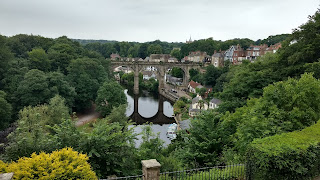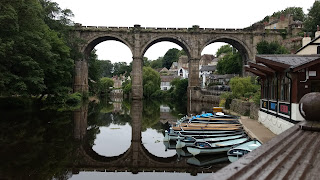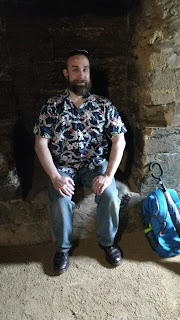Both of the older kids had school on the 4th of July, so Matt, Clara, and I decided to celebrate by wandering around Knaresborough.
We took the train, and the first thing we did was grab breakfast and a (much needed) coffee at a waterfront cafe. The food was good, and the view was very nice.
 |
| Sausage sandwich |
 |
| Full English |
Next we just walked around a bit.
 |
| I wouldn't want to use this narrow driveway! |
 |
| "Flowers! Cute!" |
We saw a sign for Knaresborough Castle, so we headed that direction. We had to go up a lot of stairs...
... and through a lovely park.
 |
Big hill
|
 |
| Just a little farther up |
Then we were standing in what used to be the moat. The lady at the museum said that the ground was very porous, so it was a dry moat. There would have been sharpened logs pointed out, and unpleasant waste items (like animal carcasses, or what they cleaned out of the toilet). Whatever they could do to make it undesirable to travel through.
There were some pretty amazing views from the top.
We bought an admission ticket, which allowed us to see inside the castle ruins and the courthouse.
According to the volunteer at the museum, much of the castle was destroyed during the
English Civil Wars. When the Parliamentarians took control of the country, they demolished many such buildings and sold off the stones. Some housing in town might contain materials from this castle. In Knaresborough, the townspeople petitioned to conserve the keep and the courthouse, to have a place to carry out justice.
First we went into the King's Tower. There were several rooms (or partial rooms) to explore here, and a nice information sheet to carry around. And the best part was that we were allowed to take pictures of everything.
The dungeon. This room was originally used to store provisions, and became a prison by the 16th century. The walls were 15 feet thick, and there was only one small window to provide light. It was hard to get pictures here because the room was small, but I did try.
 |
| The room was built around this central column. This gives you a sense of scale. |
 |
| The window |
 |
| Medieval graffiti |
 |
| More graffiti |
Next we explored the main floor, which had the servant's quarters, the buttery, and the garderobe.
Servant's Quarters. This was the area where the servants worked and lived. They slept on thin straw mats (so much for being a king's servant). The room was the same shape as the dungeon, but larger. There was a huge fireplace, which would have acted as sort of a central heating for the building.
 |
| Fireplace |
Garderobe, aka the toilet. The seat has now been capped with concrete. This was a larger room, as clothes were also stored here (the smell would keep moths away). There was a chute leading underground, which could be a weak point in the castle's defense. So it was common to really let the waste build up before having servants clean it out. Gross. Of course, we took pictures of ourselves sitting on the toilet (we are classy like that).
Buttery. This room originally stored barrels, or butts. The Keeper of Butts lived here (this is where the term butler originated). After the rest of the castle was destroyed, this tiny room was used as a prison. Up to 26 prisoners were kept here at one time! I promise this would be more impressive if my picture showed how small this room really is. Just believe me when I say that no one would've been able to lie down.
The King's Chamber. We traveled up the servant staircase to get to the king's chamber. And maybe I'm chicken because I broke my leg on stairs (one step, I broke my leg going down one step), but I was a little freaked out here. Going up wasn't that bad, but I was almost scooting down on my butt on the way back. Have a look.
 |
| Not much room to move around |
 |
| The stairs were so worn. And they were damp, which made them more slippery. |
 |
| My extra careful descent. I couldn't even think about Matt carrying Clara. |
There wasn't a lot left of the actual king's chamber. Our information sheet told us that the king would've sat on the raised area, with a fireplace on one side and a (probably stained glass) window on the other. This is where the king hung out, but his bedroom would've been the next floor up, which was completely gone.
 |
| This is where he would sit |
 |
| Fireplace |
 |
| Window |
A bit anticlimactic after the stairs, no?
Courthouse. After viewing the keep, we walked across the bowling green to the courthouse. There was a small room set up to look as it would have in the Tudor age, then a couple of rooms with artifacts. We could have spent more time here, but we wanted to make the tour of the sallyport.
 |
| Courtroom |
 |
| Courtroom |
 |
| Stocks |
 |
| 3D beadwork |
Can you read the text in that last picture? The shirt was worn by Sir Henry Slingsby when he was beheaded. A little gruesome, but interesting.
Concluding our visit to Knaresborough Castle was the tour of the sallyport. Built in the 13th or 14th century, this was an underground tunnel that provided secret entry to and exit from the castle.
 |
| The entrance wouldn't have been quite this obvious at the time. It was probably hidden under a stable or blacksmith's floor. |
 |
| Inside the tunnel |
 |
| Exit into the moat |
The lovely tour guide waited until we were outside again before telling us about the protected species of cave spider that lives inside. So I won't be joining that tour again, but I'm glad I did it once.
We had just enough time after our exploration to eat lunch before we needed to catch our return train. We decided on fish and chips, since it was on the way.
It was excellent. The batter was light and crispy, and the chips were cooked perfectly.
We made the train easily, and had the perfect amount of time to pick the kids up from school.
Of course, the kids didn't have any sort of Independence Day celebration at school, but Miles did bring home a few coloring sheets. I love how inclusive the school is.
Happy (late) Independence Day to my fellow Americans!


































































No comments:
Post a Comment